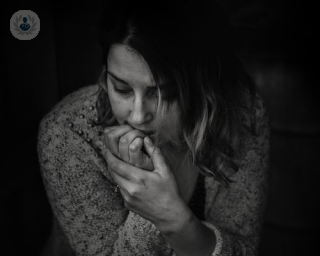Vulvar cancer
Dr Natalia Povolotskaya - Obstetrics & gynaecology
Created on: 09-21-2015
Updated on: 06-27-2023
Edited by: Karolyn Judge
What is vulval cancer?
Vulval (or vulvar) cancer happens when tumour cells start developing in the vulva, a woman's external genitals. The vulva includes the labia minora and labia majora, the clitoris, the vaginal orifice and the urinary meatus (your waterworks opening). Vulval cancer tends to spread locally to the vagina, urethra, perineum and anus. It also spreads regionally to the groin lymph nodes, pelvic lymph nodes. In later stage it can spread as far as lungs.
Vulval cancer is relatively rare. In the UK it is the 20th most common female cancer and 4th most common gynaecological cancer.
It is more common in older women over the age of 65. The Incidence of vulval cancer has increased by 18 per cent since the early 1990s, mainly due to an increase in incidence of over 50 per cent in those under 60 years.
According to the Office of National Statistics (2018) in 2016 1059 women were diagnosed with vulval cancer. There were majority of women over 60, but there were about 25 per cent between the age of 45 and 59 and 5 per cent are women younger then 45.
Apart from age other risk factors:
- Vulval intraepithelial neoplasia (VIN) is a vulval skin condition which may become cancerous if left untreated. VIN is an uncommon condition. VIN is commoner in immunocompromised women (for example Being infected with HIV or on immunosuppressive medications) and women who smoke.
Majority of VIN (90 per cent) is so called usual VIN, that is associated with Human papilloma virus (HPV) infection. The other type of VIN is differentiated VIN. It is commonly associated with Lichen sclerosus and other skin conditions that affect the vulva
- Paget’s disease can give rise to adenocarcinoma of the vulva. Often there is a delay in diagnosis as may look like eczema.
- STI - herpes
There are several types of vulval cancer:
90 per cent are made of:
- Squamous cell carcinoma of vulva. Cancer cells usually begin developing in the outer skin surface of the vulva. The main risk factors for disease are infection with high-risk HPV and inflammation due to vulval dermatoses, such as lichen sclerosus and lichen planus.
The remaining 10 per cent are made of:
- Adenocarcinoma of the vulva arises from Bartholin’s glands (glands with on each side of the opening of the vagina) or on the background of Paget’s disease. Bartholin’s gland carcinoma may present with more advanced disease, since they arise deep to the surface of the skin and are less clinically obvious or can be misdiagnosed for Bartholins’s Gland Cyst.
- Melanoma Primary vulval melanoma is uncommon comparatively with those at parts of the body exposed to the sun ultraviolet.
Unfortunately, vulval melanoma commonly presents with a more locally advanced lesion than skin melanoma, since the area is difficult to inspect. The lesions can be brown, or pink in colour. They are typically asymmetric, with irregular borders and uneven pigmentation and there may be surface ulceration. Up to 25 per cent may be amelanotic (without usual pigmentation).
- Sarcoma extremely rare, difficult to diagnose.
- Basal cell carcinoma Distant disease spread is rare. Once excised it has good prognosis.

What are the symptoms of vulval cancer?
The most common symptoms of vulval cancer are:
- A persistent itch, soreness or tenderness in the vulva, burning sensation, or burning on passing urine, pain.
- A lump, nodule or wart-like growth on the vulva which you can feel by touching it.
- An open sore or mole on the vulva that changes shape or colour.
- Red, white or dark patches of skin that are raised and thickened.
- In the most advanced stages, foul-smelling vaginal discharge; blood-stained vaginal discharge, bleeding, groin lump
Most women will experience symptoms many months before the diagnosis of vulval cancer.
As it is difficult to self-examine the area and often the ladies feel embarrassed to talk to a doctor about their symptoms, the vulval cancer often present at later stages.
It is advisable to seek medical attention if there are changes in the usual appearance of your vulva. Although they might not be due to vulval cancer, these changes need to be investigated.
How is vulval cancer diagnosed?
To diagnose vulval cancer, the gynaecologist will examine your vulva.
The most important test is to take vulval biopsy.
Often it is done under local anaesthetic, when a small piece of suspicious area is taken, sent to the lab and analysed under microscope. Sometimes the area is so sore that the biopsy can only be done under general anaesthesia. If the vulval biopsy can be taken by a general gynaecologist, further investigation and management is undertaken by the Cancer team, commonly by a Gynaecological Cancer Surgeon.
Once the vulval cancer diagnosis is confirmed histologically, you will require to have other tests to assess where else the cancer may have spread. These are:
- Computed tomography (CT) scan
- Magnetic resonance imaging (MRI) scan
- Sometime PET scan may also be required
- In later stages when the cancer is extensive and there is a need to confirm its spread with direct visualisation, Cystoscopy ( bladder endoscopy ) or /and proctoscopy ( endoscopy of the rectum and anal canal) may be required.
What is the prognosis of vulval cancer?
The outlook for vulval cancer is determined by the stage of the diagnosis and the age of the patient. The average five-year survival rate for vulval cancer is 70 per cent. After treatment patient can be discharged after 5 years, but lifelong follow up would be beneficial as vulval cancer can come back any time and better to be dealt with when it is a small area or recurrence.
How can vulval cancer be prevented?
Your risk of HPV infection (which can lead to vulval cancer) can be reduced by getting an HPV vaccine. It is most effective when received prior to exposure to HPV infection, but there could be useful still as may cover the types of `HPV infection the person may not have been exposed yet.
You should also avoid smoking and remember to go for regular gynaecological check-up if you were diagnosed with conditions that are associated with vulval cancer. Early detection will help timely treatment and improves prognosis.
How is vulval cancer treated?
Vulval cancer treatment varies according to which stage the tumour has reached and to your general state of health. This is important to bear in mind as a lot of the women who get this type of cancer are over the age of 65.
Vulval cancer is treated by the gynaecological oncologist/gynaecological cancer surgeon. Multidisciplinary team approach is standard in any cancer treatment. Multidisciplinary team includes radiologists, pathologists, medical and clinical oncologist, who have expertise in gynaecological cancers.
The most common treatments include:
Surgery: depending on the extent of the cancer, the surgeon may need to remove only the cancer and surrounding tissue (Wide local excision), a small part of the vulva (partial vulvectomy) or the entire vulva (radical vulvectomy) including the inner and outer labia, and sometimes even the clitoris.
In other cases, the doctor may decide to remove a few nearby lymph nodes (sentinel node biopsy) or many lymph nodes of the inguinal and pelvic area, where some tumour cells may be.
Surgery to treat vulval cancer carries a risk of infection and problems with healing in the area around the incision. It can cause the vulval deformity and difficulty with sexual intercourse due to scarring. The removal of lymph nodes can cause fluid to be retained and affect the leg or the genitals, known as lymphedema.
- Radiotherapy: it is usually done before or after surgery, using external beam radiation of X-rays, to kill cancer cells or shrink large vulval cancers. If you can’t have surgery, radiotherapy can be done to relieve the symptoms of the tumour. Radiation therapy can also be done in the area around the lymph nodes, if you have cancer cells in your lymph nodes.
- Chemotherapy: the drug is administered via injection. Its purpose is to destroy the tumour cells in your body. Chemotherapy is often done together with radiotherapy in order to fight a cancer which has reached an advanced stage.
Which doctor should I talk to about vulval cancer?
Though the assessment by an expert in vulval cancer is the shortest way to the diagnosis. The first examination often is done by a general gynaecologist. If vulval cancer is suspected or diagnosed you will be referred to a gynaecological oncologist surgeon.
After assessment of the tumour size and the tumour spread, or after excision of the tumour by a gynaecological oncologist surgeon, you may need to be referred to a clinical oncologist if you need radiotherapy, or a medical oncologist if you need chemotherapy.
Will I experience pain following surgery for vulval cancer?
Similar to every type of surgery, you will experience temporary bruising and swelling after the procedure. This will heal and fade over time.
The vulva may look different after surgery, especially if the labia had to be removed. Some women may notice a change in the sensation of the vulva. In case of a large lesion, plastic reconstruction of the vulva is considered.
Will vulval cancer treatment affect my sex life?
Scarring after vulval cancer treatment may cause numbness and/or pain during sex. The ability to have an orgasm may also be affected, but this depends on how much of the vulva, lower vagina and/or clitoris had to be removed. Persistent swelling sometimes develops in women who have had lymph nodes in the genial region removed, making sex painful.
Will vulval cancer affect my ability to have children after?
Wide local excision or vulvectomy is unlikely affect a woman's fertility but may affect sexual intercourse and labour. If more advanced surgery or chemo or radiotherapy are required, you need to discuss with your surgeon how it would affect you having children. Vulval cancer occurs in 95 per cent of women older than 45. The majority of women have completed their families by that stage of their lives.











